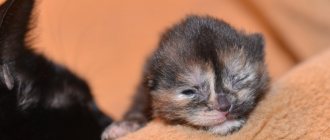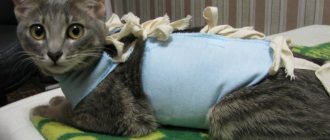How do cats behave day by day after sterilization?
The general condition and behavior of the cat after sterilization changes daily.
Day 1
On the first day after surgery, the cat has no appetite, lethargy, drowsiness, coordination of movements is impaired, hallucinations and disorientation may occur - the pet tries to run or crawl in an unknown direction, stops abruptly, runs into walls, falls and falls asleep, jumps up, etc. This behavior is normal and there is no reason to worry.
The cat may not blink, in which case it is necessary to close her eyes yourself until she starts blinking again, otherwise there is a risk of drying out the cornea.
In addition, involuntary urination and vomiting are possible.
On the first day after sterilization, you need to be close to your pet and monitor its condition. You cannot feed the animal, but only give it water from a syringe or pipette.
Day 2
During the second day, the cat begins to come to its senses, its behavior becomes more adequate. The pet has a desire to hide in dark, hard-to-reach places, so it is necessary to monitor it and constantly keep it in sight.
If a cat is in pain, it may try to bite someone who tries to touch it.
At this time, the animal shows a desire to lick the area near the incision and reacts too excitedly to all extraneous sounds.
On the second day, you can put water near the animal and start feeding it in small portions.
Day 3
On the third day, the cat fully comes to her senses: she is active, reacts with interest to what is happening around her, goes to the litter box and begins to ask for food.
You need to measure your pet’s body temperature twice and, if the readings are elevated or decreased, contact your veterinarian.
Due to the fact that anesthesia can slow down intestinal motility, it is necessary to monitor the regularity of bowel movements and, in the absence of bowel movements, you can give the cat mild laxatives.
Day 4
On the third day after sterilization, the cat should eat and drink independently, and should actively urinate and defecate.
Day 5
On the fifth day, the swelling and redness near the suture subsides, and scarring begins.
The cat is becoming more and more active and can now walk around the apartment.
And if before the operation the pet had access to the street, then into the yard, you can jump on low surfaces.
Day 6 and 7
By this time, the pet’s activity and appetite are completely restored, pain completely disappears, urination and bowel movements occur as usual.
Host reviews
Ekaterina, 31 years old, Novosibirsk
I found Fenya in the winter as a tiny kitten that someone dropped at our entrance. Because of the cold, it seems she couldn’t even meow, she was so frozen, poor thing... Naturally, I couldn’t pass by this half-dead lump, I took her, warmed her up and left her with me.
When I picked her up from the street, I didn’t even know that she was a female kitten; this became clear later, during an examination at the clinic. Then the doctors asked me if I would later sterilize Fenya, I answered no. But when I returned home, I started thinking about what would happen next. Fenya is a cat, which means that sooner or later she will have kittens that will need to be adopted. And it’s not that there would be many problems with the device, it’s just... I didn’t want one of my cat’s children or grandchildren to end up on the street, just like she once did, where they might have been hit by a car or torn apart by dogs.
The decision to sterilize was not easy, but the reluctance to endanger the lives of Feni’s future kittens overcame all fears. And so, when my cat was eight months old, I took her for surgery, which she endured surprisingly easily. True, some surprises awaited me at home, starting with the fact that Fenechka slept for a very long time on the first day - at least half a day after sterilization, and when she came to, she lost orientation in space for some time: she kept bumping into something on the walls, then on the furniture in the room. I was even afraid that she had gone blind due to the anesthesia. However, after a while everything got better and, apart from the fact that the cat was still quite lethargic and apathetic, she at least no longer looked stunned as she did on the first day after the operation.
Nowadays, six months after sterilization, I can say that Fenin’s character has hardly changed: she was still a sweetheart. Well, maybe she became a little more calm and imposing. But this may not be at all related to sterilization, the cat has simply matured - that’s all.
Victoria, 24 years old, Tomsk
We didn't originally plan to have our Brittany spayed. The cat was taken for exhibitions and breeding, but, as it turned out, everything is not so simple. While the kitten was small, everything was fine, but then Bree began to mark her territory. I would never have thought that cats, especially purebred ones, could do this! I no longer wanted any kittens, but only wanted one thing: for the cat to stop dirtying the apartment. At the family council, the issue of sterilization was adopted, and, having agreed on the operation at the clinic, my husband and I took our failed breeder cat there.
Of course, we had fears that something might go wrong. But the doctor calmed us down, told us not to worry, and that, most importantly, we were on time with the operation: a few more months and it would have been impossible to wean Bree from leaving marks even after sterilization.
What can I say about our main problem? It really resolved itself in the best possible way, however, in addition to the operation, I also had to additionally raise a cat. Nevertheless, we are pleased with the result and are sure that without sterilization, Brittany would have continued to cause mischief in the apartment.
Yaroslav, 42 years old, Stavropol region
Muska of a simple noble breed was given to us by our relatives as soon as we moved into the house, they say, when we move, we need to introduce the cat first, so that there will be happiness in the house. We appreciated their gift only later, when it turned out that our underground was full of mice. Fortunately, Muska, despite her very young age, coped well with them, and at least they didn’t snoop around our kitchen and rooms. And for the time being everything was fine, until our cat unexpectedly went on a spree. We still don’t know where she gave birth to kittens and hid them for the first weeks. She brought her offspring to us when they were already grown up, so we had to add her brood almost immediately after that. How we accommodated them in the village is a separate conversation, but after this incident it was decided to sterilize Muska so that this epic with cat children would not happen again. But we were afraid that after the operation the cat would become lazy and not want to catch mice. But, fortunately, it turned out that this was not the case. As a result, despite the fact that after sterilization Muska is still an excellent catcher of mice, it even seems that she has begun to catch more of them than before.
Condition of the cat immediately after sterilization
The well-being of a cat after sterilization depends on several factors:
- age at the time of surgery;
- whether the procedure was planned or emergency;
- type of anesthesia used.
Is the animal in pain?
After recovering from anesthesia, the animal may experience pain, which usually goes away on the second day. The main signs of postoperative pain are:
- manifestation of aggression;
- dilated pupils;
- prolonged immobile stay in one position;
- gaze directed at one point;
- refusal to eat.
To alleviate your pet's condition, you should give her a painkiller injection or give her an anesthetic drug orally.
Important!
The use of any drug must be agreed with a veterinarian.
Why might a cat be overly active?
Postoperative behavior depends on the individual characteristics of the cat, its psyche and stress tolerance.
After sterilization, some animals may consider themselves completely healthy, not feel any discomfort, continue to lead their usual lifestyle, or become hyperactive.
This behavior negatively affects the recovery process. Due to increased activity, a cat may bite, scratch, show aggression towards people or animals around it, and attack them.
It is better to prepare for this behavior of your pet in advance by equipping it in a cool, calm, isolated place. It is necessary to limit the animal’s movements, ensure complete rest, and you can add sedatives to the water.
Increased appetite: eating too much
Sterilization leads to the cessation of the production of sex hormones that reduce appetite, so in a sterilized cat it increases, metabolic processes slow down, as a result of which the pet’s body weight may increase.
It is necessary to control the amount of food your cat eats and feed it with specialized food often, but in small portions.
Display of aggression
Surgery and recovery from anesthesia are stressful for the animal. The cat is in pain and reacts overly excitedly to surrounding sounds, any noise and people around. All this affects behavior that may become uncharacteristic for her: the pet may hiss, growl, try to bite and show aggression.
Important!
You should isolate the cat by locking it in a carrier or a separate room - this will minimize the effect of irritating factors on the animal and will help you quickly return to normal behavior.
The animal yells, screams, hisses or growls: what to do?
Loud screams and aggressive behavior from a cat indicate that it is experiencing severe pain or nausea. If your pet screams for a long period of time, you need to contact a veterinarian who will examine her, determine her condition and, if necessary, prescribe painkillers.
Also, during the postoperative period, the cat may scream if an incomplete operation was performed - in this way the pet demonstrates character and asks the cat. In such a situation, the best solution is to perform a complete operation to completely eliminate the cat's sex drive.
In addition, a cat may scream in order to attract the attention of the owner.
Postoperative suture care
Caring for a cat after sterilization involves treating the sutures. The seam must be dry and clean. Any suppuration, bloody wetting or inflammation is a reason to contact a veterinarian. In order for the seam to heal faster, it must be treated with the following drugs:
- Levomekol ointment;
- hydrogen peroxide;
- Betadine;
- Chlorhexidine;
- brilliant green.
In the first days after surgery, swelling of the suture may be noted. This is a completely normal tissue reaction to injury. Sometimes redness of the seam is observed, and the skin around it takes on a glossy appearance. Ichor (clear liquid) may appear. On average, the suture heals completely on the 10-12th day after surgery.
Sutures in cats should be removed at 7-10 days, because the threads then begin to grow into the skin. This can be done at a veterinary clinic or on your own. There is nothing complicated about this. You need to take tweezers and small scissors. The instruments are disinfected, after which you need to pull the thread with a knot with tweezers, and cut one thread with scissors. In this way, all seams are gradually removed.
Video
How long does it take for an animal to move away?
The cat sterilization operation is performed in a veterinary clinic and lasts approximately 40 minutes. The length of time the animal recovers from anesthesia depends on which of the three types was used:
- Muscle relaxants + analgesics. This mixture is used most often as it is the most effective. A significant disadvantage of such anesthesia is the difficult and rather long recovery from it, which lasts from 5-6 to 24 hours.
- Muscle relaxants along with epidural anesthesia. When using this type of anesthesia, the experience and qualifications of the doctor play an important role, since if the injection into the epidural space is performed incorrectly, there is a risk that the sensitivity of the hind limbs and the ability to move them will return within 48 hours. The advantage of this mixture is its low toxicity, due to which anesthesia is easily tolerated and recovery from it takes a maximum of 8 hours.
- Gas or inhalation anesthesia. This method is highly effective and minimally toxic, but it is used infrequently due to the lack of necessary equipment and substances. After such anesthesia, the animal comes to its senses almost immediately after the anesthesia machine is turned off.
How to help your pet?
There are a number of recommendations from veterinarians for the process of cat rehabilitation at home:
- you need to put the pet on the floor, since due to impaired coordination of movements after anesthesia, it may fall from a hill;
- the cat should not lie near heating appliances - this can cause internal bleeding;
- It is worth laying down an absorbent diaper, as the cat may spontaneously urinate, defecate or vomit;
- you need to put the pet on its right side to reduce the load on the heart;
- if a cat has a weakened immune system, it needs a course of vitamins and restoratives;
- in the first hours after surgery, it is necessary to measure the cat’s temperature once an hour and carefully turn it over every half hour to avoid numbness in its paws;
- if ulcers, crusts, rashes or redness form in the suture area, consult a veterinarian;
- in case of sudden vomiting, it is necessary to turn the cat’s head to the side and make sure that it does not choke;
- to prevent licking and scratching of the stitches, as well as to protect the wound from dust and dirt, you need to put a postoperative blanket on your pet;
- stitches must be treated in accordance with the recommendations of the veterinarian.
Important!
If symptoms such as bleeding from the suture, the cat's heavy breathing, wheezing in the chest, uneven heartbeat, pale or red mucous membranes, or a rash occur, you should immediately take the animal to the veterinarian.
If all recommendations are followed, the cat will recover from anesthesia easier and recover faster.











